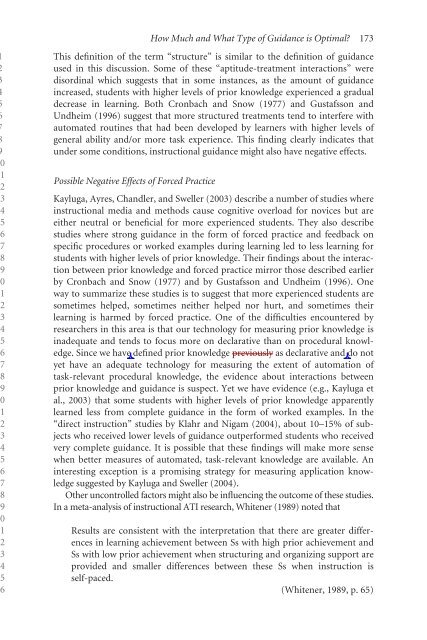9 How Much and What Type of Guidance is Optimal for Learning ...
9 How Much and What Type of Guidance is Optimal for Learning ...
9 How Much and What Type of Guidance is Optimal for Learning ...
Create successful ePaper yourself
Turn your PDF publications into a flip-book with our unique Google optimized e-Paper software.
<strong>How</strong> <strong>Much</strong> <strong>and</strong> <strong>What</strong> <strong>Type</strong> <strong>of</strong> <strong>Guidance</strong> <strong>is</strong> <strong>Optimal</strong>? 1730123456789012345678901234567890123456Th<strong>is</strong> definition <strong>of</strong> the term “structure” <strong>is</strong> similar to the definition <strong>of</strong> guidanceused in th<strong>is</strong> d<strong>is</strong>cussion. Some <strong>of</strong> these “ aptitude- treatment interactions” wered<strong>is</strong>ordinal which suggests that in some instances, as the amount <strong>of</strong> guidanceincreased, students with higher levels <strong>of</strong> prior knowledge experienced a gradualdecrease in learning. Both Cronbach <strong>and</strong> Snow (1977) <strong>and</strong> Gustafsson <strong>and</strong>Undheim (1996) suggest that more structured treatments tend to interfere withautomated routines that had been developed by learners with higher levels <strong>of</strong>general ability <strong>and</strong>/or more task experience. Th<strong>is</strong> finding clearly indicates thatunder some conditions, instructional guidance might also have negative effects.Possible Negative Effects <strong>of</strong> Forced PracticeKayluga, Ayres, Ch<strong>and</strong>ler, <strong>and</strong> Sweller (2003) describe a number <strong>of</strong> studies whereinstructional media <strong>and</strong> methods cause cognitive overload <strong>for</strong> novices but areeither neutral or beneficial <strong>for</strong> more experienced students. They also describestudies where strong guidance in the <strong>for</strong>m <strong>of</strong> <strong>for</strong>ced practice <strong>and</strong> feedback onspecific procedures or worked examples during learning led to less learning <strong>for</strong>students with higher levels <strong>of</strong> prior knowledge. Their findings about the interactionbetween prior knowledge <strong>and</strong> <strong>for</strong>ced practice mirror those described earlierby Cronbach <strong>and</strong> Snow (1977) <strong>and</strong> by Gustafsson <strong>and</strong> Undheim (1996). Oneway to summarize these studies <strong>is</strong> to suggest that more experienced students aresometimes helped, sometimes neither helped nor hurt, <strong>and</strong> sometimes theirlearning <strong>is</strong> harmed by <strong>for</strong>ced practice. One <strong>of</strong> the difficulties encountered byresearchers in th<strong>is</strong> area <strong>is</strong> that our technology <strong>for</strong> measuring prior knowledge <strong>is</strong>inadequate <strong>and</strong> tends to focus more on declarative than on procedural knowledge.Since we have defined prior knowledge previously as declarative <strong>and</strong> do notyet have an adequate technology <strong>for</strong> measuring the extent <strong>of</strong> automation <strong>of</strong>task- relevant procedural knowledge, the evidence about interactions betweenprior knowledge <strong>and</strong> guidance <strong>is</strong> suspect. Yet we have evidence (e.g., Kayluga etal., 2003) that some students with higher levels <strong>of</strong> prior knowledge apparentlylearned less from complete guidance in the <strong>for</strong>m <strong>of</strong> worked examples. In the“direct instruction” studies by Klahr <strong>and</strong> Nigam (2004), about 10–15% <strong>of</strong> subjectswho received lower levels <strong>of</strong> guidance outper<strong>for</strong>med students who receivedvery complete guidance. It <strong>is</strong> possible that these findings will make more sensewhen better measures <strong>of</strong> automated, task- relevant knowledge are available. Aninteresting exception <strong>is</strong> a prom<strong>is</strong>ing strategy <strong>for</strong> measuring application knowledgesuggested by Kayluga <strong>and</strong> Sweller (2004).Other uncontrolled factors might also be influencing the outcome <strong>of</strong> these studies.In a meta- analys<strong>is</strong> <strong>of</strong> instructional ATI research, Whitener (1989) noted thatResults are cons<strong>is</strong>tent with the interpretation that there are greater differencesin learning achievement between Ss with high prior achievement <strong>and</strong>Ss with low prior achievement when structuring <strong>and</strong> organizing support areprovided <strong>and</strong> smaller differences between these Ss when instruction <strong>is</strong>self- paced.(Whitener, 1989, p. 65)
















